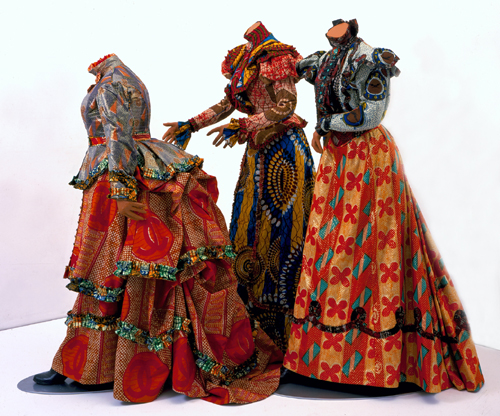Entangled Global Patterns of Cultural Identity
/by Patty Chang
Yinka Shonibare, Three Graces.
Textile patterns and dress provide a rich visual vocabulary of encoded information and aesthetic expression. They have the ability to exploit or subvert the commercial allure of the “exotic”, and how it is called upon to reference cultural or national identities or even recast the vernacular. The exhibition Pattern ID, which is currently on view at the Akron Art Museum, queries just how straight forward patterns and dress inform our understanding of cultural identities. The multimedia exhibition entitled, Pattern ID, features the works of Mark Bradford, iona rozeal brown, Nick Cave, Willie Cole, Lalla Essaydi, Samuel Fosso, James Gobel, Brian Jungen, Bharti Kher, Takashi Murakami, Grace Ndiritu, Yinka Shonibare MBE, Mickalene Thomas, Aya Uekawa, and Kehinde Wiley. Many of these contemporary artists have migrated from one culture to another, be it national, ethnic, racial, socioeconomic, political or religious. Rather than trade one identity for another, the artists reveal ways in which identity can be cumulative, employing a patchwork of textile patterns and dress as meaningful vehicles to locate one’s place in society against a backdrop of globalization. Taking a range of approaches from humor to irony and formal beauty, these artists borrow from popular culture, world history, and art history to transform and redefine the cultural meanings of patterns.
For instance, the use of African textiles as props and backdrops in the works of Yinka Shonibare, Samuel Fosso, and Grace Ndiritu play not only on traditional and modern forms of representation, but also on cultural myths, politics, and ideas of post-colonialism, reclamation, and subjugation. The headless mannequins in Shonibare’s Three Graces fashioned in elaborate Victorian garb made out of atypical ‘African’ fabrics and arranged as a tableau satirizes the notions of authenticity and identity. The installation relies as much on the Dutch wax-print cloth ‘ethnicizing’ the space as on the references to 18th and 19th century masterpieces of European art. However, it is the textile that is a testament to cross-cultural interactions brought about by mercantile trade, having undergone a series of replication, transformations, redefinitions, and repackaging for different markets and tastes. Although linked by ideas of post-colonialism and identity, his works are not necessarily contained by them.
Grace Ndiritu, Still Life
Similarly, Samuel Fosso’s photograph Le Chef: celui qui a vendu l’Afrique aux colons (The Chief: The One Who Sold Africa to the Colonizers) is part of a series of self-portraits created in 1997 for the Parisian department store Tati, that depict the photographer in little else other than leopard skins, holding sunflowers, and draped in gold jewelry seated against a backdrop and foreground of Dutch wax-print fabrics. The contrasting patterns form a subversive portrait of corrupt African leadership and the regalia of indigenous kingship. The camp imagery deliberately projects an ‘exotic' Africa as the world sees it. Moreover, Grace Ndiritu’s Still Life depicts four video installations inspired by Matisse and his love for the female nudes and African textiles. Inverting the colonial gaze, she transforms the female nude from a passive decorative object into an active subject. The African textiles wrapped and draped around her models are used to elicit countervailing emotional stereotypes of repression and sexual freedom.
Samuel Fosso, Le Chef: celui qui a vendu l’Afrique aux colons
Elsewhere in the exhibit Aya Uekawa and Kehinde Wiley incorporate highly stylized decorative pattern motifs within their portraits, while also referencing the realism of Dutch and Flemish 16th and 17th century painters, and the styles of European portraitists such as Reynolds, Gainsborough and Titian, respectively. Although Wiley has used models in the past from West Africa, he mainly works with African-American models as a symbol of hybridization and globalization through the African diaspora. In many instances, cultural identity is lifted out of its traditional anchoring in a particular locality and redefined in a hybrid context that is still coherent and intensely beautiful. One of my personal favorites is the variation of Soundsuits by Nick Cave, who created elaborate costumes out of fiber textiles and found objects to be worn by dancers as a vehicle for sound and movement. The suits have an ethereal quality reminiscent of a fusion of Leigh Bowery’s performance pieces and certain body-hiding masks and ceremonial costumes from African, South Pacific, and Caribbean cultures.
Nick Cave, Soundsuits, Installation View, Akron Art Museum.
One of the major divides on globalization today is whether the increased speed, scale and volume of international trade is imposing cultural homogenization or in fact, working to enrich and preserve culture through expanded access to the internet and increased cross-cultural contact. Interestingly, many of the works featured in this exhibition assert a more complex, multivalent understanding of our contemporary condition, namely one that takes into account hybrid forms of cultural expressions that are not entirely global or local, indigenous or imported, or Western or non-Western. As historian Benedict Anderson suggests, a passport may come to signify permission to work someplace more than a connection to any essential collective identity or pledge of national allegiance.
Nick Cave, Soundsuits
*Pattern ID: International Artists Fashion their Global Identities is on view at the Akron Art Museum through May 9, 2010.










